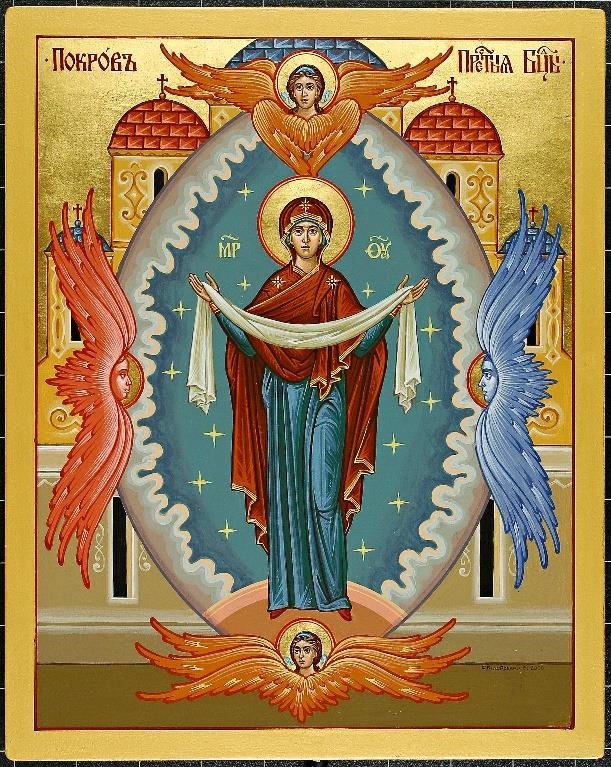The icon showing the Theotokos standing with her arms outstretched in prayer and draped in a veil (omophorion – Pokrov) recalls the story of her miraculous appearance in the Blachernae church in Constantinople likely in the mid-tenth century. This occurred one night as the church was filled with the faithful praying for deliverance from enemies. St. Andrew, known as the Fool for Christ, and his disciple Epiphanius saw the Theotokos enter the church and face the sanctuary. There she tearfully prayed for a long time after which she approached the Bishop’s Throne and continued her prayer. Then taking her veil she turned to those present, and held it out over them, showing her intention to protect them from enemies both visible and invisible. Read a fuller version of the event here. In the icon she holds the omophorion and is flanked by angels. This is a meeting of heaven and earth. Behind her we see the Mandorla or nimbus, reminding us of this presence of heaven on earth. In the background are the multiple domes depicting the Cathedral of Blachernae where the event took place.
In many icons of the Protection of the Most Holy Mother of God, such as the one on the right, the faithful who were gathered in the church are depicted. Some accounts of the event tell us that as the Theotokos stood in the church St. Andrew and Epiphanius saw her surrounded by saints and martyrs from throughout history, reminding us of the eternal unity of the Church; the communion of saints. In this example we see St. Andrew in the bottom right, dressed in a rough cloak and his disciple Epiphanius beside him gesturing in amazement toward the miraculous vision. Various saints including the twelve apostles are often depicted. Here we can see St. John the Baptist on the right who is specifically mentioned in accounts of the event. Most icons of the feast also portray St. Romanus the Melodist in the centre beneath the Theotokos. He is clothed in a deacon’s sticharion and holds an open scroll.

On the scroll is the text of the Kontakion for Nativity in honour of the Mother of God which tradition tells us, was his first composition after he himself experienced a miraculous vision of the Theotokos. Emperor Leo the Wise and the Empress appear in the lower left corner.
The feast of “Pokrov” is not one of the 12 major feasts of the liturgical year. However, it holds a special place in the hearts of the Ukrainian people who posses a great love and devotion to the Mother of God and look to her as their protectress. In 1036, Prince Yaroslav the Wise built the Church of Assumption in Kyiv after a great victory at war. In 1037, in that same church, he entrusted the entire nation to her guardianship. The appearance of the Mother of God at the Pochaiv monastery in Ukraine, during a Turkish siege in 1675 is familiar to most Ukrainians. In response to the fervent prayers of the monks and the faithful, the Theotokos appeared over the monastery church and held out her omophorion (veil) as she did in Blacharnae.
This feast is also referred to as the Protection of the Most Holy Mother of God, The Patronage of the Most Holy Mother of God, The Patronage of the Theotokos, The Protection of the Blessed Virgin Mary and the Protection of the Theotokos.
Through the celebration of this feast we are reminded of the unending protection that is ours through the intercession of the Most Holy Theotokos and we are encouraged to flee to her mercy and compassion at all times of trouble.

